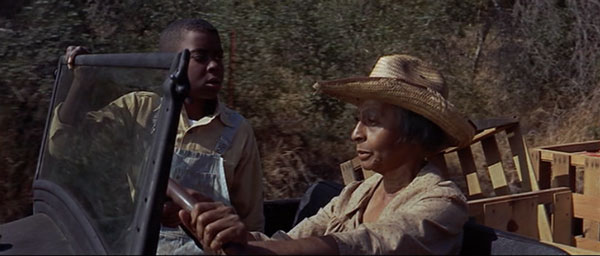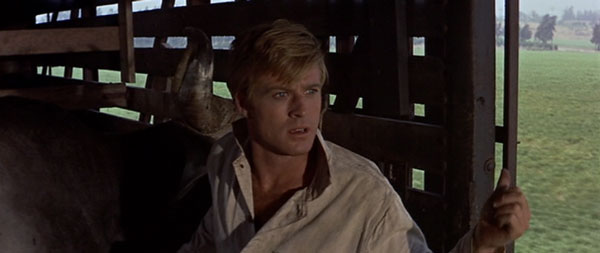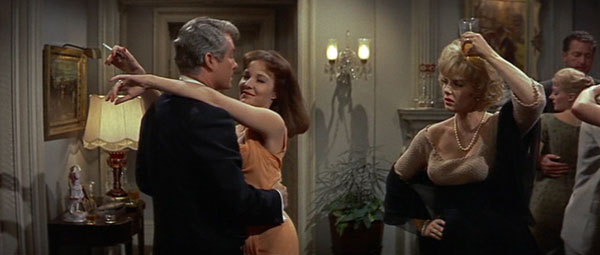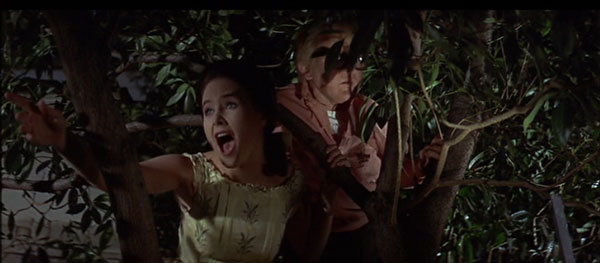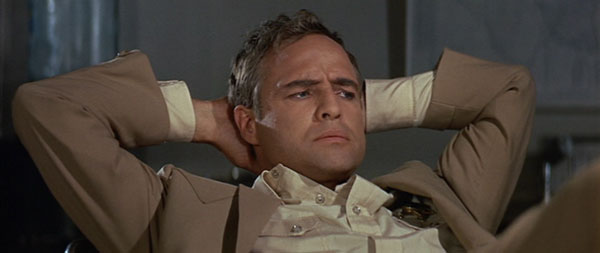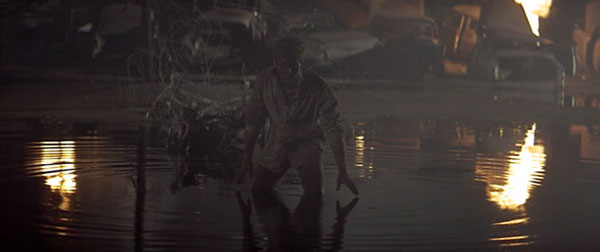Arthur Penn's American Agonia: THE CHASE
The Chase plays tonight at 7 p.m. at the Pacific Film Archive, Berkeley, as part of the retrospective Arthur Penn, a Liberal Helping, showcasing 9 of the 10 major works by the great director. Click here for more information about this series.
In 1965, the United States was splitting apart at the seams. In February, Malcolm X was assassinated. March saw the landing of the first American combat troops in Vietnam; that same month, Martin Luther King, Jr. made three attempts to lead Civil Rights marches from Selma to Montgomery, Alabama, finally succeeding on the 21st. On April 17th, the Students for a Democratic Society held their first march against the Vietnam War, which brought 25,000 protesters to Washington.
That summer, during which the Watts Riots irrupted in August, the 42-year-old Arthur Penn sweated on Hollywood sound stages, directing his fourth motion-picture, The Chase. Though barely into middle-age, Penn had already spent decades immersed in theater-work. The younger brother of photographer Irving, Penn had found refuge during his impoverished adolescence in the Depression 30’s by joining the technical crew of the Neighborhood Playhouse in Philadelphia. After service in the army as a soldier in the European Theater of WWII, Penn was recruited to army theater, directing shows for troops in Germany during the Occupation. Back home, he went to Black Mountain College on the GI Bill, then got a job with NBC during the early days of TV. Penn had fallen hard for actors, and directed some of the best while working on live television productions. 1958 saw the release of his first movie, The Left Handed Gun, starring Paul Newman as Billy the Kid. Penn found the Hollywood experience frustrating from the get-go, and returned East to begin a stellar career directing on Broadway. His production of The Miracle Worker was a smash hit, and he became attached to its movie version; his efforts were rewarded with an Oscar nomination for Best Director. Penn bristled at convention and success: he followed The Miracle Worker (1962) with Mickey One (1965), a tragicomic noir, in which existentially alienated stand-up comic Warren Beatty plays Joseph K. to the mob; this movie ranks among the most openly experimental films ever released by a Hollywood studio.
From the beginning of his film-work, Penn had been acclaimed in Europe. The Left Handed Gun had been lauded in the pages of Cahiers du cinéma by François Truffaut. Ingmar Bergman is said to have later proclaimed him “one of the greatest directors in the world”. Mickey One might have had the effect of rendering him déclassé with movie-moguls; fortunately, by the time it was finished, he was already under contract to one independent mogul for whom Penn reeked of class all over. The Austrian-born Sam Spiegel had plenty to spare of his own: three of his productions found him awarded “Best Picture” Oscars: On the Waterfront (1954), The Bridge Over the River Kwai (1957), and his most recent, Lawrence of Arabia (1962). For his latest, he’d hired Lillian Hellman to adapt a play by Horton Foote. In keeping with his trend toward Super-Production bloat, Spiegel intended to put together a cast like no other — when The Chase comes to mind, I often think of Billy Wilder’s gag in The Apartment (1960) of Jack Lemmon settling in with a TV dinner to watch a movie on the tube (“From the World’s Greatest Library of Film Classics, we proudly present Greta Garbo, John Barrymore, Joan Crawford, Wallace Beery, and Lionel Barrymore in GRAND HOTEL. But first, a word from our sponsor… Friends, do you have wobbly dentures?”) For my two-bits, The Chase leaves Grand Hotel in the dust: Marlon Brando, Robert Redford, Jane Fonda, Angie Dickinson, Robert Duvall, James Fox, Janice Rule, E.G. Marshall, Martha Hyer, Miriam Hopkins, Paul Williams (yes, that Paul Williams!), and the list goes on and on. Those are just the leads of this ensemble cast; character parts are rounded out in the same prodigious manner. Some of the leads have lapsed into obscurity: Miriam Hopkins, for example, had been the delightfully bubbly ingenue of Lubitsch’s Trouble in Paradise (1932) and Design for Living (1933). Matha Hyer had played a major role in one of the greatest 50’s Hollywood melodramas, Vincente Minnelli’s Some Came Running, in ’58. Others were destined for later greatness: Robert Redford was barely a star at this point, and Janice Rule would play the third of Robert Altman’s 3 Women in ’77. To Spiegel, the edgy, arty Penn would be in tune with The Chase‘s whirling vortex portrayal of a very Southern-feeling rural Texas town as the contemporary representative of hell. His technical credentials were impeccable, his reputation amongst actors already unparalleled: Penn would be perfect to helm such a production. With only three movies under his belt, and only one of these a hit, he might prove easy to control.
As an instantly haunting/gorgeously agonizing John Barry score looms out of the darkness, headlights catch the figures of two escaped convicts on a country road. Making their way through a brilliantly-colored maze-montage of the film’s Maurice Binder-designed credits (Binder was famous at the time for similar services to James Bond), the two trick a passing driver into stopping. Bubber Reeves (Robert Redford) is a charmer of a prison escapee: his essential innocence is swiftly revealed by the naive running commentary he directs at the world, and the shock when his seeming-compatriot senselessly murders the driver and takes off in the car solo. “Wha’d you do that for?! BUTCHER!” he screams, in hot pursuit. A Model-T era car drives by, and a dialogue by its occupants reveals The Chase‘s startlingly clear-eyed view of race: a young black boy says to the old lady farmer beside him: “Grandma, he’s got a prison suit! We gotta tell somebody!” Her eyes remain fixed firmly in the distance: “Turn your head back, and keep it there. We gotta do nothing except let white men take care of white men’s troubles. Sit you still, boy.”
Bubber understands the USA as a place from which to escape; he jumps a freight train. A stunned family of migrant workers disabuses him of his presumption when he points the way the train’s headed. “Mexico?” he asks. They shake their heads and point the opposite direction. He leaps from the open car, plunging into the river below. An instinctive creature, Bubber seems as subconsciously directed as a homing pigeon…
Meanwhile, in Bubber’s unnamed native-town, Sheriff Calder (Marlon Brando) senses trouble brewing. Word has gotten out about Bubber’s escape, and the town gadflies are certain he’ll return to exert all manner of retribution. Seems Bubber’s initial turn for the bad occurred when as a kid, one of his cohorts, Edwin (Robert Duvall), let him take the rap for a stolen $50 he himself had swiped. Years of reform school and playing town scapegoat have left him bewildered and resentful. It’s no surprise everyone expects the local hellion to run wild…
Bubber’s wife Anna (Jane Fonda) is caught betwixt and between; she loves two men. The daughter of the town floozy, she never knew her father, and her childhood romance with the regional scion, Jake Rogers (James Fox, midway between The Servant and Performance), was nipped in the bud by his father Val’s class prejudice. Since Bubber wound up in the state pen for drunkenly “borrowing” Val’s airplane, her romance with Jake has rekindled…
Jake, a Fisher Prince, shields his frozen torment behind dark shades. The filial duties of this repressed non-psychotic correlative to Jim Thompson’s Lou Ford require him to dispense placatory platitudes on a grand scale to his father’s oil-drilling and crop-picking minions, but the bitter irony of these is all-too apparent: “We’ve labored hard, and deserve the happiness which all Americans know to be their birthright!” he shouts back at the roughnecks as he climbs into his boat-like sedan. When the earnest Mexican foreman of his father’s farm delivers a bad approximation of a departing worker’s complaints, he’s savvy enough to provide his own: “He said my father, the unclean son of a pig, could keep his television, and pay more money.” It’s all in a day’s work for Jake. “The cotton’s all chopped”, he says, turning with reasonable good will to the workers packed in the back of a truck. “Vaya con Dios! See you back at the rice crop.”
Anna’s and Jake’s love is genuine, even passionate, but tempered by pained history. Between them came the colossus bestriding this town, which is bestrewn with signs emblazoned “Val Rogers Properties”. The pathetic irony binding the region together in a twisted union is that the Great Mr. Rogers emotionally is barely more than a paper tiger: he desperately loves the son he hamstrung years before, but any potential avenue for communication between the two has been sealed shut; Jake’s life is sham, trapped by a lifeless marriage entered into to please the Patriarch…
At the nexus of this Southern hotbed is Sheriff Calder, a swift and sensitive man whom everybody in this burg seems to think has “Val Roger’s Property” stamped on his forehead. Indeed, he does owe his job to Val, who hankers for Calder’s wife Ruby (Angie Dickinson). But Calder is a decent man, one, in fact, who strives to do good; a former gentleman farmer, he yearns to get the hell out of Dodge, and back on his feet. When the word comes that Bubber has been spotted on the town’s outskirts, his nerves are pricked: Calder, more than anyone in “Val Rogers Properties”, knows that he minds a powder-keg…
Is this stew hot enough for you? Well, dear readers, it’s barely begun its boil. Remember, this is the mid-60’s: apocalypse is part-and-parcel of daily life. As the sweltry day mellows to steamy evening, separate gatherings of the rich, the young, and the ripe middle-aged ensue. Liquor flows; improbable, lusty rock-n’-roll ripples through the Properties. This is your classic small-ville Americana set-up, with bed-jumping and wife-swapping galore. Hate and desire intermingle; a network of power and status relations amongst the town’s younger gentry reveals itself, each of its strands connected, though usually at cross-purposes, to Val Rogers, the black hole who exerts his gravitational force amongst all and sundry. Further down the power-grid is Emily Stewart (Janice Rule), wife of Edwin (Robert Duvall), a slinky, lubricious queen bee who delights at unleashing chaos. Rule’s character occasions many of the film’s spot-on overheated exchanges, every bit as startling as the film’s portrayal of race. Emily, coming on to Calder in front of both her husband and lover: “All you need to come to my party is a pistol, and you got one.” “With all the pistols you got there, Emily, I don’t believe you’d have room for mine,” he rejoins.
As hysteria regarding Bubber mounts with every bump and grind, real pistols are pulled and discharged, first only in the air. But the swelling violence needs release; a black man is almost lynched, saved in the nick of time by Calder. Across town, Bubber has made it to an auto-salvage Wasteland inhabited by a black associate, Lester (Joel Fluellen), and guilted him into getting word to Anna. Caught alone in the absent “white girl’s room”, Lester now becomes the target of the small band of hyped-up white supremacist thugs, before Calder again fortuitously arrives on the scene, spiriting Lester away to jail for safety. As Anna and Jake search for Bubber, Val Rogers searches for his son. Word spreads that a “nigger” in the jail knows where Bubber Reeves hides: the fuse is lit. With only Calder and his dignity to stem the building Dionysian frenzy, the latent tensions explode. Teenagers get in an the act: a girl shrieks, claiming she’s spotted Bubber. Paul Williams leaps in the air, declaring “I’m Bubber Reeves!” In the junkyard, Bubber awaits, surrounded by stacked wrecks of cars, and with a full underground tank of gas on the premises…
If ever there was a work that captured the discombobulated (yet seemingly orchestrated) horrors of mid-60’s USA, The Chase is it. The summit of overdetermined melodrama, Penn’s film is packed with blocked protagonists, multiplied Oedipal dynamics, razor-sharp social observation, convulsive sex and violence, and a unique brand of sensual cinematic technique. Although this is Tragedy American Style, brash and tawdry (with the town’s bit-players as chorus), The Chase bears relation to Fassbinder in its portrayal of a world determined by arbitrary hierarchy, riddled with sadomasochism, and crippled by contingency. It’s an America of Balzacian complexity, covering all the bases: the high and low-born, the white, black, and brown. It was a highly personal work for Penn; like most conscious people of the time, he was horrified and obsessed with the era’s mass violence and assassinations; its final of many crucifixion-climaxes reworks Ruby’s killing of Lee Harvey Oswald, and implies Kennedy’s presumed assassin to be a sacrificial scapegoat for America, with the holy innocence of Jesus, but none of His Redemptive power.
At this point, it will be no surprise that The Chase is one of my favorite films; unfortunately, it was not one of Penn’s. After the shoot, he left to fulfill a contractual obligation to direct Wait Until Dark on Broadway; it was his understanding editing would commence when he was free. To complete this vision of a world askew, of injustice piled upon injustice, Sam Spiegel took matters into his own hands, setting a team of editors to work, and hiring Barry and Binder. The results were simply stunning, but they weren’t Penn’s: over the years, until his death last year, he repeatedly described how the takes used by the editors weren’t the ones he would have chosen. He considered the loss of several takes of Brando charged with improvisatory expressiveness one of the great misfortunes of his career. The Chase was released in February ’66, took a critical drubbing, and enjoyed disastrous box-office response. Seems folks wanted some redemption in their 60’s hell; Penn’s next film, made with sympathetic producer Warren Beatty, would provide just that: Bonnie and Clyde (1967) is one of the most legendary hits of the art.
I agree with Ingmar Bergman: Arthur Penn is one of the greats. I sometimes have issues with his acting, however: it’s often just a tad too expressive. Penn was one of the Avatars of Method, and for a period directed the Actor’s Studio, the philosophy of which is decidedly actor-centric. I love actors, but not all roles, scenes, and movies require the baring of their souls. Sometimes portrayals of social reality, of people as they appear in daily life, do the trick. Penn declared himself against ensemble-playing, and for a theatrical “anarchy”, with everyone expressing themselves, rather than a collective vision. I’d love to see Penn’s version, but The Chase, as it is, is jam-packed with almost too much anarchy for human comfort. The various collectivist states of the last hundred years to the contrary, the USA is the supreme millenarian country on Earth. In our very bowels we believe hope never dies, perfection is achievable, and who knows? Utopia may be around the corner. Bonnie and Clyde provided moviegoers with redemptive scapegoats, as Easy Rider did two years later. These were Romantic figures with which to identify.
The Chase might be seen as a work of “automatic writing” by its filmmaking collective, or even the Western collective subconscious. The ripping of Penn’s Utopian yearnings from his film via the editing mirrors the sacrificial rending of The Chase‘s multiple protagonists, the effect of which is possibly a more honest, or at least clearer-eyed vision of the truth of its times, than provided by the romanticized redeeming-savior couple at the center of Penn’s equally brilliant Bonnie and Clyde. If the latter film struck a nerve by providing a helpfully flattering portrait of its audience, The Chase held up a mirror to the full swathe of humanity’s madness as well as promise: it’s the most potent cinematic portrait of collective impotency I’ve come across. Ranking with the greatest films disowned by their directors, The Chase is a work of shattering perception.
Since posting this article, I was able to meet and briefly speak with Nat Segaloff, author of Arthur Penn: American Director, who introduced the 6/18 PFA screenings of Alice’s Restaurant and Bonnie and Clyde. Segaloff’s new and essential first biography of Penn details many (to my knowledge) previously undocumented details of The Chase’s history. For example: before Lillian Hellman was engaged, Sam Spiegel hired blacklisted (and ultimately uncredited) screenwriter Michael Wilson to do the first draft adapting Foote’s play; after Hellman shaped the main body of the script with Penn, Ivan Moffat and Horton Foote himself (!) were brought in for re-writes. Via email, Nat Segaloff generously helped to refine my brief account of The Chase’s production; this piece has been slightly tweaked to reflect his feedback. Thank you, Nat!

